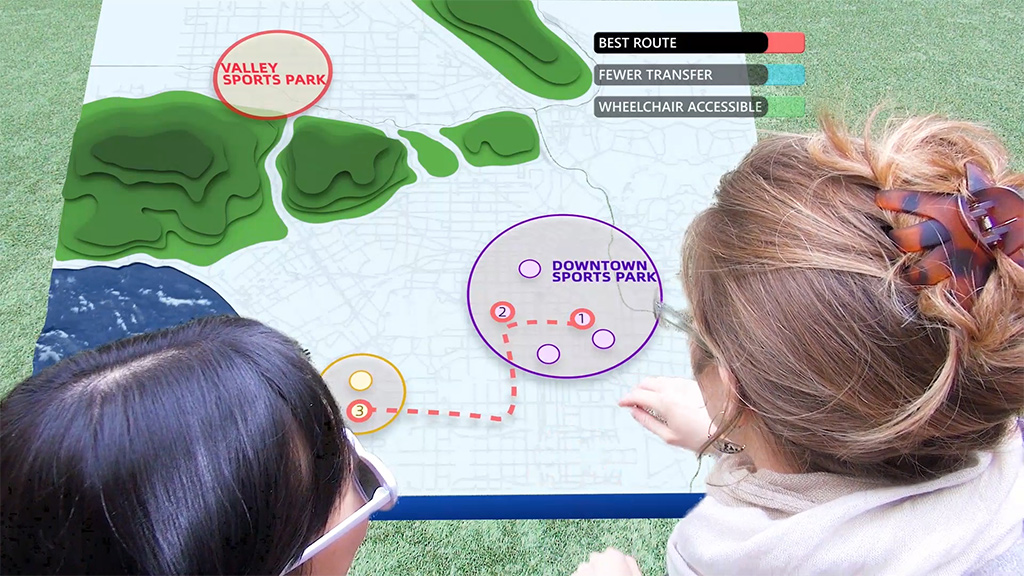Mixed Reality Futures for Connected Transit
November 17, 2020 | By Stephanie Truong
How can we design digital-physical experiences for public spaces that provide a safe, frictionless way to interact with the city?
The Context
As rideshare services and other mobility innovations proliferate, transit ridership is declining nationwide. In large metropolitan markets — including New York and Chicago — transit ridership is at its lowest level since 2005. Despite adding new stations, Los Angeles metro is failing to attract new customers. Concerns with efficiency and safety, along with increased access to tech-enabled transit alternatives such as Uber and Lyft, are motivating an increasing number of people each year to seek out other means of transportation. With the ongoing COVID-19 health crisis, the city of Los Angeles is hoping to provide assurance and incentive to its riders. With all this in mind, transit systems must focus on new and novel ways to optimize rider experience.
Augmented reality (AR) has the capability to create a frictionless, connected system for all transit users. Through a digital platform, we can map out the full user journey and provide a safe, integrated, and accessible user experience.
What We Did
We explored how AR can enhance the passenger experience and support the ridership of LA’s public transit system. To begin, we held a brainstorming and visioning session with City of Los Angeles, LADOT, FAST, Metro OEI, The Bloc, CivicConnect and other entities to gather information and feedback on user types, the current passenger journey, pain points, and opportunities. We then designed a user interface for an AR platform integrated with The Bloc and the 7th Street metro station in Los Angeles. After refining the platform features, we filmed a visualization of our AR interface at The Bloc to further demonstrate our concept.
The Results
AR has the capability to create a seamless, connected system for all transit users. Through the digital platform, we can map out the full user journey and provide a safe, integrated, and accessible user experience. Creating a digital space provides the instant resources that travelers need to navigate their journeys and destinations, creating a customizable experience for each rider.
We identified six key features for our digital platform:- Trip planning, ticketing, and traffic information to help users select their routes, purchase rail passes, and navigate line transfers.
- An AR concierge that welcomes riders to the transit system and guides them through the app’s features.
- Wayfinding and event notifications that direct passengers to their destinations and alert them to nearby activities and sites.
- Real-time translation that allows passengers to communication with and understand their environment, regardless of language barriers.
- A virtual avatar for each user that stores frequent rider points.
- A social platform that allows passengers to make new friends and connect with them on existing social media sites.
Design Implications
AR platforms can foster feelings of community — even among first-time visitors. A connected digital infrastructure will benefit metropolitan hubs around the world that accommodate vast numbers of tourists. This feature will be especially beneficial during events such as the Olympics, the World Cup, and other global gatherings.
An integrated digital experience can boost rider connections with surrounding businesses. AR has the agility to keep up with rapidly changing retail and mixed-use environments. With dedicated wayfinding and alert systems, this technology helps first-time users maximize their experiences.
AR platforms can help transit systems build their brand. Currently, users of LA’s metro rail system feel that the stations lack a distinct look and feel. AR platforms provide a site-specific way for customer to interact with the physical environment, yielding increased opportunities for place-making features.
What’s Next
AR is a powerful emerging platform that has the potential to positively shape user experience and better connect our cities. AR revenues are projected to exceed 27.4 billion by 2023 (up from 1.96 billion in 2018). Public and private agencies must be educated on how they can leverage their resources to better accommodate the increasing demand for AR integration. By helping these organizations bridge the gap between our physical and digital environments, we can increase connection and accessibility through the power of design. With this user experience to storytelling and urban planning, we can begin to see what the future of a more connected Los Angeles will look and feel like. With this technology, AR can become one facet of a rich LA experience — one that is contextual, seamless, and accessible to all.
For media inquiries, email .

